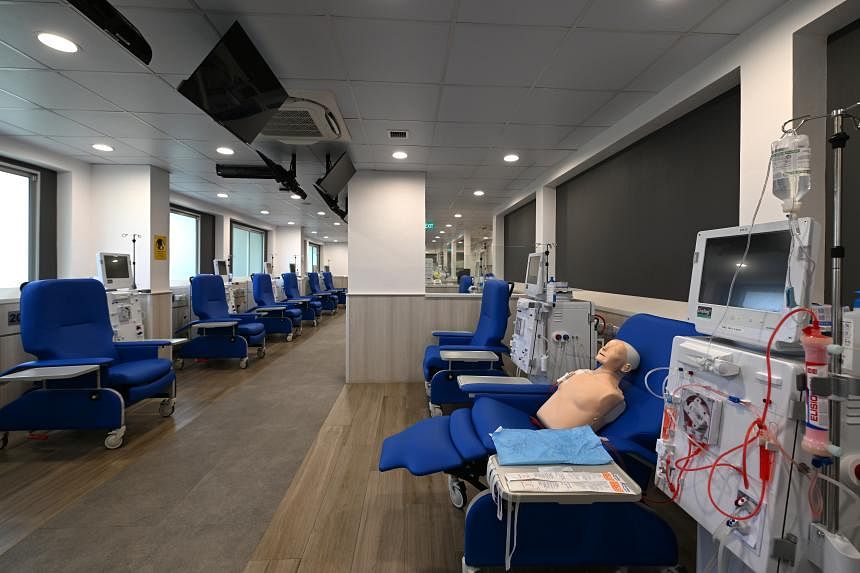SINGAPORE – The number of people getting kidney failure here has gone up by 40 per cent over the past decade, with significantly more men and Malays suffering from it.
Among patients starting dialysis in 2022, three in five were men, while proportionately, three times more Malays than Chinese suffered from kidney failure.
For every one million Malays, 459 required dialysis in 2022, compared with 150 per million for Chinese, and 183 for the Indian population.
Kidney failure, or fifth-stage chronic kidney disease (CKD5), happens when the kidneys lose their ability to function, resulting in the accumulation of waste products and fluid in the body.
Kidney disease is a major problem in Singapore.
Globally, one in 10 people suffer from CKD. In Singapore, it is higher. The National Population Health Survey 2022 found that 14 per cent of the population had CKD, up from 9 per cent two years earlier.
One in four people here – close to 900,000 people – will suffer from CKD by 2035, according to projections by experts from the National Healthcare Group and the National University of Singapore published in an article in the International Journal of Nephrology in 2018.
The largest proportion, however, will have early stages of the disease, they said.
There are five stages of CKD. Stage 1 and 2, or CKD1 and CKD2, are considered mild, with the kidneys still working fairly normally. But over time, the kidneys will deteriorate, with the condition progressing to CKD5, or end-stage renal disease where the kidneys are close to not working or have failed altogether.
Singapore has the third-highest incidence of CKD5, after Taiwan and the United States, according to the US Department of Health and Human Services.
In 2021, 2,155 people were diagnosed with kidney failure – or about six new cases every day – against 1,557 in 2012, according to the Singapore Renal Registry Annual Report 2022 released in January 2024. The number of new CKD5 patients in 2022 was not available, as the registry tracks patients for at least six months to ascertain kidney failure.
The number of patients starting dialysis went up by 50 per cent between 2012 and 2022. Now, there are four new dialysis patients a day.
The report said that in 2020, Singapore had the world’s highest percentage of kidney failure patients starting treatment whose disease was due to diabetes – at 67 per cent.
To cope with the rising numbers, the National Kidney Foundation (NKF), the biggest dialysis provider here, runs 41 dialysis centres to care for slightly more than half of the roughly 9,000 people who are on dialysis.
This includes one centre that was opened in Bukit Batok in January. Another centre will open in Sengkang in May, and three more centres will be added by 2025.
An NKF spokesman said the number of patients on haemodialysis – where a person’s blood is removed, cleaned and returned to the body – has gone up by 72 per cent in the past decade, from 2,672 in 2014 to 4,595 in 2023.
The age of NKF’s patients ranges from 22 to 96.
There is some good news, however, as the median age of new dialysis patients at NKF has gone up over the past five years, from 62.5 to 66 in 2023 – which means people have functioning kidneys for longer.
Much of the increase in kidney failure is caused by an ageing population. When age is taken into account, the number of people with kidney failure as a proportion of the population has remained fairly stable over the past decade, according to data from the registry.
However, with new and better treatments to help patients slow the progression of kidney disease, doctors are hoping to see a slowing down in the rise of kidney failure here.
As to why more men and Malays suffer from this life-threatening disease, Dr Chua Horng Ruey, who heads the kidney disease division at the National University Hospital (NUH), said it is because more of them suffer from underlying conditions that contribute to the organ’s failure.
He said the latest national population health survey showed that more men suffer from diabetes, hypertension, high cholesterol levels and obesity, so “we could reasonably assume that more males than females would suffer the unfortunate outcome of kidney failure in later years”.
Dr Yeo See Cheng, who heads the renal medicine department at Tan Tock Seng Hospital, agreed that men tend to have more underlying medical conditions that increase their risk of getting kidney failure, but suggested there might be another possibility.
“The reason for the higher rate of kidney failure in men is postulated to be biological, namely, negative effects of testosterone compared to the protective effect of oestrogen in women,” Dr Yeo said.
Dr Chua said more Malays suffer from cardiovascular disease, which is a major risk factor for kidney failure.
“Malay patients referred for kidney disease management at NUH versus other ethnic groups were more likely to have three or more comorbid conditions, such as diabetes, hypertension, hyperlipidaemia, heart disease or stroke.
“We could again reasonably assume these are reasons why there are disproportionately more Malay patients than Chinese with kidney failure.”
Dr Angeline Goh, a renal expert at a clinic in Mount Elizabeth Medical Centre, said “the proportion of Malay patients with worse kidney function on presentation was also higher, and they tended to miss appointments”.
She added that more Malays have metabolic diseases, such as high blood pressure, high cholesterol levels, excess abdominal fat and diabetes, but they are less likely to keep up with their medical appointments, so their condition worsens. This is a reason why many more Malays suffer from kidney disease.



